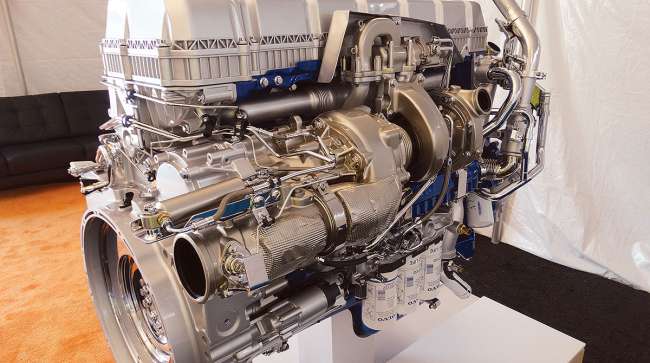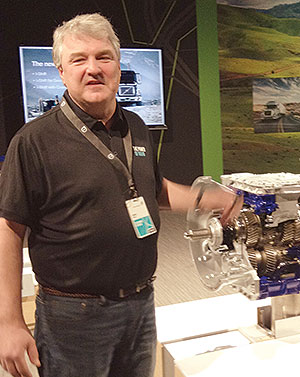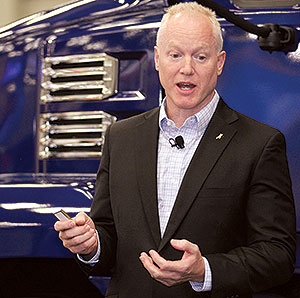The Upside of Downspeeding

Industry experts and fleets tell us that engine downspeeding is a great way to save fuel at highway speeds and that it affords additional benefits.
Downspeeding works by getting today’s engines closer to their sweet spot — saving fuel with little or no loss of performance.

Baxter
The technique produces such high efficiency because sufficient torque is now available at more efficient, ultralow rpms. Each drop of 100 rpm produces 1% to 1.5% in fuel savings.
“Running engines at lower rpms drives the best efficiency possible,” said RaNae Isaak, powertrain and total-cost-of-ownership consultancy leader at engine maker Cummins Inc.
As a result, downspeeding is rapidly taking over in trucks that cruise down the highway.
“The majority of our fuel-economy specs are down-sped, and there is a growing trend in all applications to migrate toward faster axles,” said Patrick Dean, chief engineer at Kenworth Truck Co.
Faster axles save fuel when engines generate more power at lower rpms.
Dean said the Paccar MX13 engine, with 1,850 pound-feet of torque, provides 390-420 horsepower at a down-sped rpms.
Aaron Peterson, chief performance engineer for heavy products at Navistar Inc., said 60-65% of the truck maker’s Class 8 tractor sales have down-sped drivetrains. The company’s A26 engine provides 380-400 horsepower at 1,250-1,200 rpm, he said.

Volvo's John Moore by Rip Watson/Transport Topics.
John Moore, Volvo’s product marketing manager, said over a third of the company’s tractors are down-sped with its unusually low-rpm turbocompounding system. The Volvo D13 with turbocompounding delivers 360 horsepower at only 1,070 rpm, he said.
This is much more than what is needed to maintain a 65 mph cruise. Moore said only 140 horsepower will maintain 65 mph with a VNL tractor. Other estimates range from 190-200 horsepower, but 360 horsepower or more will be much more than enough to cruise on a level road. Grades beyond 1% may require a downshift, but experts say most grades on interstates can be taken one gear down at a reasonable speed.
Joel Morrow, senior driver and head of research and development for Norwalk, Ohio-based Ploger Transportation, recommends an “overdrive and direct drive overlap in the peak torque range.” This means gearing so either of the top two gears can be utilized at cruise speed while still down-sped.
“This is a huge advantage for not only fuel efficiency but on-demand pulling power as well,” Morrow said.
Nearly all engine manufacturers recommended cruise rpm in the range of 1,150-1,200 for downsped engines with the standard, variable geometry turbo.
For the Volvo D13 with turbocompounding the recommendation is 1,070 rpm, and with Mack’s similarly equipped MP8HE, 1,050-1,250 rpm.
There’s a handy formula for determining horsepower at cruise rpm.
“Horsepower equals engine rpm times torque divided by 5,252,” said Roy Horton, director of product strategy at Mack Trucks. Using this formula, the power output of a Mack MP8 at the downsped cruise rpm of 1,150 would be 407 horsepower, he said.

Mack's Roy Horton by John Sommers II for Transport Topics.
“You can calculate any engine’s horsepower at cruise rpm this way, and compare the result with the manufacturer’s estimate of the power needed to maintain 65 mph or whatever your cruise speed is,” Horton said.
Brian Daniels, manager of Detroit powertrain and component marketing, said the DD13 and DD15 engines were down-sped in 2016 to deliver required power and torque at lower rpm. Recommendations vary with the engine and transmission, but a typical spec is the DD15 with 400 horsepower and 1,750 pound-feet of torque with direct drive in top gear turning 1,200 rpm at 65 mph.
There are more benefits to this smarter way to set up the drivetrain than reduced engine friction.
Paccar Vice President Landon Sproull and several others said higher cylinder pressures and increased time for combustion enable the engine to capture more of the fuel’s energy.
They added that the turbo works better under these conditions and the exhaust gets hotter, which helps the diesel particulate filter regenerate passively, a truth Ploger’s Morrow swears by.
Volvo’s Moore allows that the increased efficiency that comes with turbocompounding means cooler exhaust but adds that this factor is considered in the design of the aftertreatment system. While no changes to the engine auxiliaries are necessary for most setups, Moore says Volvo requires a 165-amp alternator with the turbocompounding engine because of the very low cruise rpm.

